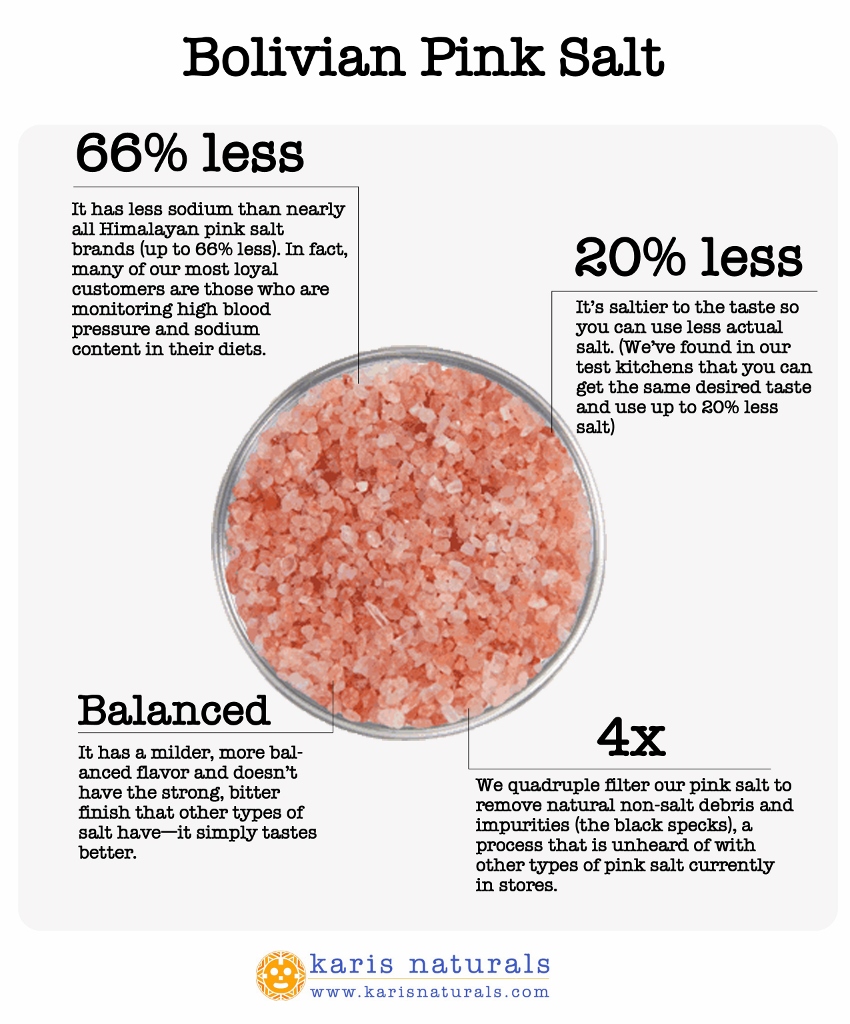Free Shipping on all orders over $50!

-
FAQ

How is Bolivian pink salt different from Himalayan pink salt?
Bolivian pink salt is sourced in South America, while Himalayan pink salt is sourced in Pakistan. Also, Bolivian pink salt tends to have less actual sodium than Himalayan pink salt. They both share similar quantities when it comes to the essential trace minerals they possess, but the taste is remarkably different. Bolivian pink salt tends to have a milder finish, whereas Himalayan pink salt is slightly more bitter in its finish.
So what IS pink salt?
Called by many as the “Perfect Salt”, pink salt contains over 80 essential trace minerals, such as iron, calcium, magnesium and potassium. It has 10 times more minerals than sea salt, and 30 times more minerals than refined salt. Pink salt’s beautiful pink speckled color is derived from iron and other minerals. For example, our Bolivian pink salt contains 3.4mg/100g of Iron (Fe), making it an excellent source of Iron compared to a close to zero dosage in refined table or Kosher salt.
Where is your pink salt from?
Unlike Himalayan Salt which is sourced in Pakistan, our Bolivian pink salt has been formed over the last 300 million years in the Andes Mountains of Bolivia. A pure deep ocean evaporated and the salt was buried under the Andes mountains, protected from pollutants. The incredible weight of the mountains over long periods of time, transformed the salt into a very special form of crystallized rock salt. Andes Pink Salt has no sediments and it is unrefined, but is crushed and delivered in its natural state.
Does pink salt taste different?
Because Bolivian pink salt is unrefined and contains zero additives, it lacks the bitter finish found in processed salts. In fact, the high quantity of essential minerals imparts a milder and full taste to the salt. The way we like to describe it is this: if processed salts (table, Kosher, sea salt) are like waking up to a bucket of cold weather, the taste of pink salt is like waking up to a warm breeze and the smell of apple pie.
Is pink salt healthier for me?
Refined white salt on food can be very bitter and metallic-tasting. This often masks the true flavor of the natural goodness of food. It’s highly concentrated sodium chloride composition does not combine naturally with food or our bodies. Initially, refined salt was intended for melting ice and snow from highways and as a component in the chemical and machinery industries. We know, we were shocked too!
Pink salt, on the other hand, is a whole food since nothing is added or taken away. Given its composition, it metabolizes readily and is easily assimilated by bodies. When sodium chloride concentrations in blood rises, neighboring cells and tissues are attracted to the salt-rich blood. Pink salt allows liquids to freely cross body membranes, the kidney, and blood vessels’ walls, while refined salt does not allow this free movement of liquids and minerals, causing fluids to accumulate in joints, producing water retention and chronic kidney problems.
How do I know if the salt I currently use is refined?
Simple. There should only be one ingredient: salt. If your ingredient list sounds like a pop quiz from high-school chemistry, then your salt is refined and processed.

Leave a Comment